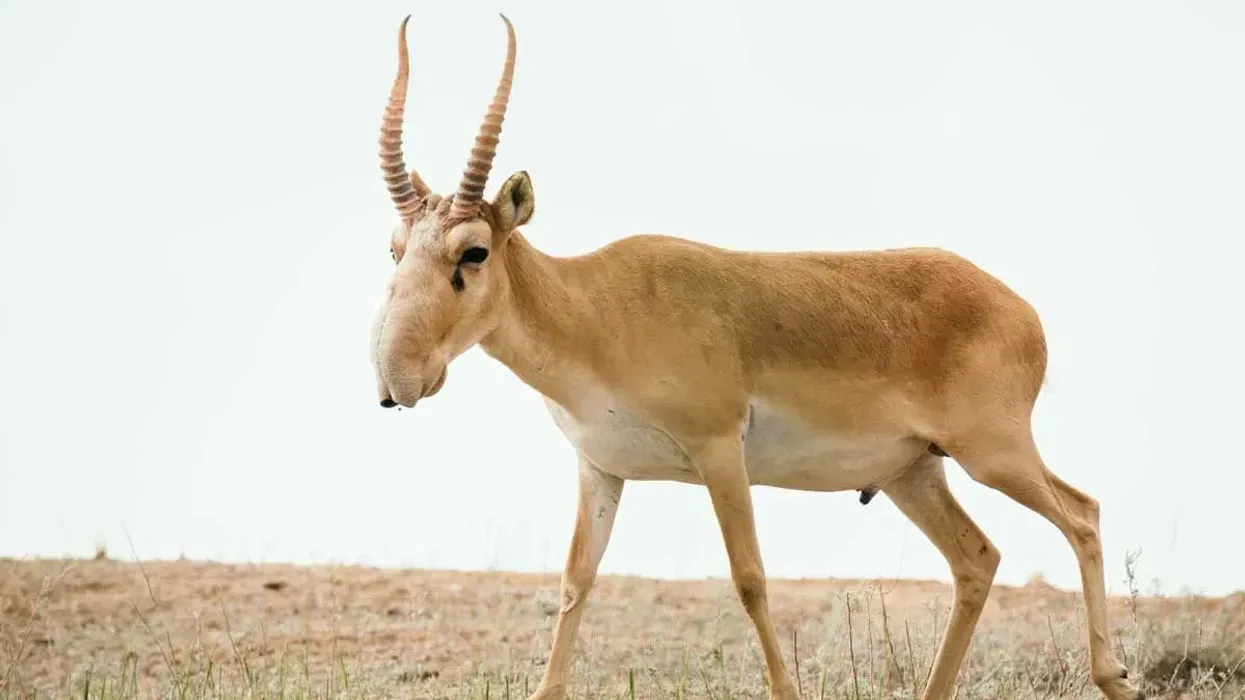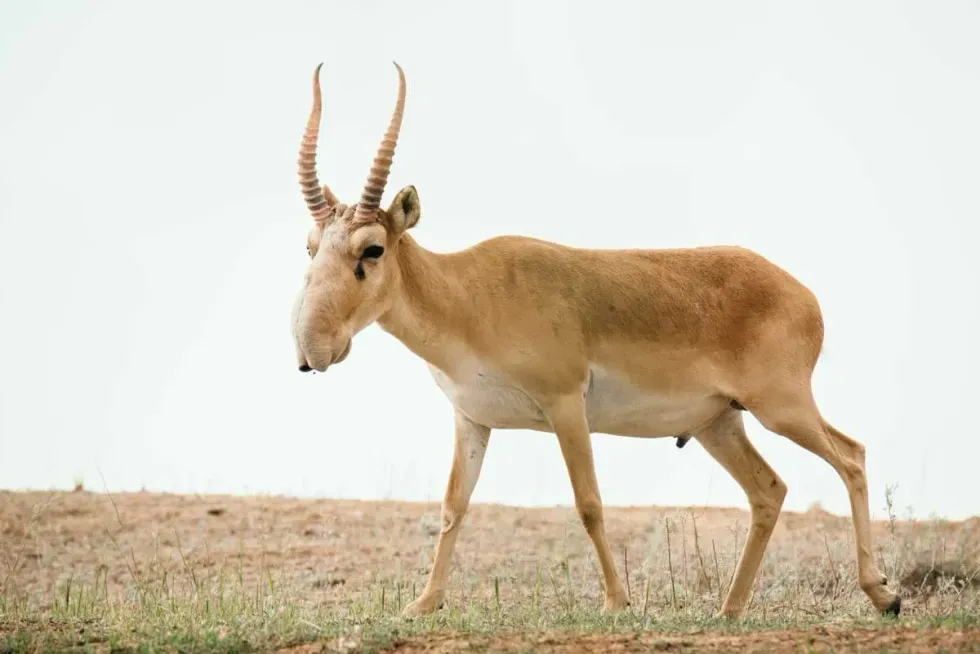The most striking feature of a saiga antelope has to be its weird-looking nose that tends to hang over its mouth. In reality, this nose helps them to filter out dust and to cool their bodies down while they travel across long distances.
This could be a reason why they prefer the arid and semi-desert-like grasslands of Kazakhstan, Russia, Mongolia, and the rest of Central Asia.
Saiga antelopes are prone to bacterial infections and this has caused a saiga antelope mass death event. Like every animal found on the planet, saigas are very important to the ecosystem of their native lands, and their extinction could lead to a major imbalance in these areas.
Males generally have a larger body than females, and their most identifying feature is their horns for which they are heavily hunted.
Females do not possess horns. Some American zoos like the San Diego Zoo keep these animals, and you will be able to visit them there.
Continue reading to learn more fun facts about saiga antelope horns and a saiga antelope snout. If you like reading this article, we suggest you check out our similar ones about gerenuk and mountain zebra.
Saiga Antelope Interesting Facts
What type of animal is a saiga antelope?
As evident by the name, these animals are antelopes and are known for their distinctively long noses. Saigas are a migratory species known to travel long distances across the Eurasian steppe and Central Asia. They are part of the family Bovidae.
What class of animal does a saiga antelope belong to?
Saiga antelopes are mammals which means that females give birth to live babies, instead of laying eggs. Twins are quite common among saiga antelopes, but they are pretty vulnerable to attacks by foxes and feral dogs.
There is another major concern for saiga antelopes as mass death tends to be a common occurrence among this species. If some are infected by deadly bacteria, large herds have been known to die out.
This, alongside, poaching for their horns, has caused their populations to decrease significantly in the Mongolian region. Thankfully in recent years, some saiga conservation groups have been working to raise awareness among people to protect this species from going extinct.
How many saiga antelopes are there in the world?
It is hard to say just how many saiga antelope are left in the world, but experts assume the numbers to be around 50,000.
Poaching and the illegal trade for the saiga horn, which is a crucial component in traditional Chinese medicine, has pushed the saiga populations to the verge of extinction. There are no saiga antelope left in China, and the population around the rest of Central Asia and the Eurasian steppe is critically endangered.
A mass dies out of the Saiga tatarica species happened a few years ago that impacted their population negatively.
Where does a saiga antelope live?
Most saiga antelope populations live in Kazakhstan, Uzbekistan, Kalmykia, Russia, and Mongolia.
What is a saiga antelope's habitat?
Saiga tatarica prefers to live in arid and semi-desert portions of the Central Asian steppe. This subspecies prefers terrains devoid of rugged mountains as their habitat.
Who do saiga antelopes live with?
Saigas are herd animals and can live in groups of up to as many as 1000 saigas. It is most common for them to live with 30 to 40 individuals.
Big herds are more common during the mating season. Big herds of female saigas also migrate together and then split into smaller groups as the mating season arrives. Large herds of Saiga tatarica are known for migrating across their natural habitat of Kazakhstan, Uzbekistan, Mongolia, and all around the Central Asian steppe to avoid terrible winters.
How long does a saiga antelope live?
Saiga antelope are known to live for only 10 to 12 years. The Saiga tatarica is very prone to bacterial disease, which is why mass die-outs have occurred and have impacted the Saiga population negatively throughout the years.
How do they reproduce?
The breeding season usually lasts from November to December. Males often battle with each other to garner the attention of female saigas.
The females of this species have a gestation period of about five months, after which, one or two saiga calves are born. It is common that saigas to give birth to twins.
The calves are known to nurse from their mothers for about three to four months after being born, but they can graze on their own after four to eight days. Strangely, calves have been known to nurse from other non-related females in captivity, but, this behavior is not common among wild saiga antelope.
What is their conservation status?
Saiga antelope is listed as a critically endangered species on the IUCN Red List. Poaching and illegal trading have pushed the saiga population to the verge of extinction. Not to mention the international trade for saiga horn is a big reason that their population has been threatened over the centuries.
These horns are valuable as they are used in traditional Chinese medicine. This has caused a mass decrease in the saiga antelope population. However, in recent years, saiga conservation methods have been introduced by wildlife groups.
Saiga Antelope Fun Facts
What do saiga antelopes look like?
Saiga antelopes have a large nose that helps them to filter out dust, which in turn cools them down when they are migrating across Kazakhstan, Uzbekistan, Russia, and Mongolia. Their odd nose also happens to be their most striking feature.
Males are known to have a couple of long horns which are adorned with ridged rings all along their length.
The males of this species look quite similar to small sheep in their appearance except for the weird nose part. The legs of Saiga tatarica are thinner compared to the robustness of their bodies.
A saiga's fur changes color in the winter and summer. They tend to have a shorter coat in the summer months with a reddish-yellow colored fur coat on their back and neck and a light-colored underside.
In the winter months, the color of their coat becomes a dull gray on the neck and back portion and a brownish-gray shade on the underside.
It also becomes longer and thicker compared to the summer coat. They are also known to have short tails compared to their large bodies.

How cute are they?
A saiga antelope can be very cute with its odd-looking nose and ringed horns. They happen to be easy targets for illegal horn trading as their horns are valuable components in traditional Chinese medicine. This has pushed the population of this subspecies almost to the verge of extinction.
How do they communicate?
Saiga antelope are tactile creatures and are known to use tactile means as well as body language to communicate with their kind. They have also been known to use loud nasal snorts and roars to demonstrate their physical strength to attract females in the case of male saigas.
Saigas are also assumed to be able to use chemical trials to communicate with their kind.
How big is a saiga antelope?
Saiga antelopes are not very tall, standing only at about 24-32 in (61-81.2 cm). They are between 39-55 in (99-140 cm). long. Females are usually a little smaller than males. Interestingly, this antelope is about the same size as a small Chinese muntjac.
How fast can a saiga antelope run?
Saiga tatarica is a migratory species and is known to move in large herds across the Central Asian grasslands through Mongolia, Russia, and Kazakhstan. As a result, they are known to be able to run very fast when chased by wolves, foxes, and other predators.
They can run as fast as 50 mph (80 kph) if they happen to feel motivated enough.
How much does a saiga antelope weigh?
Saiga antelopes are robust-bodied animals and their appearance can be compared with sheep. The difference is that they have a distinctive long nose that helps them filter out dust, which in turn cools their body down. This antelope species is known to weigh around 57-152 lb (26-69 kg) on average.
What are the male and female names of the species?
Saiga antelopes do not have gender-specific names for their male and female counterparts.
What would you call a baby saiga antelope?
A saiga antelope baby is called a 'calf'. These calves are dependent on their mothers for nursing for about three to four months after birth. Strangely, some calves in captivity have been known to nurse from other non-related females as well, but this behavior is not found among wild saigas.
What do they eat?
These antelopes are known to eat more than 100 plant species in their natural habitat. A saiga's diet includes lichens, sagebrush, saltworts, summer cypress, and fobs.
They also graze heavily on grasses, and this is thought to be the main source of food for these fascinating antelopes. In turn, adult saiga antelopes are hunted by wolves and the young ones are known to fall prey to foxes and feral dogs.
They are also hunted by humans for their horns which are used in traditional Chinese medicine.
Are they aggressive?
Male saigas can be pretty aggressive to each other and are known for battling it out regularly. These fights can turn fatal very fast as these antelopes are known for fighting violently to protect their group of females from intruding males who intend to take them over.
A male saiga does not graze during the mating season at all and spends all its time defending its group.
Would they make a good pet?
Saiga antelope are herd animals and they might suffer from serious psychological damage from being separated from their kind. Saiga antelopes are also a migratory species that are known to travel long distances and keeping them confined goes against their very nature.
This species is also very prone to diseases that have impacted their population heavily in a negative way. This also makes them very hard to care for.
Did you know...
Interestingly, only a male saiga has the infamous horn that saigas are heavily hunted for.
Why are saiga antelopes endangered?
Typical adult saiga antelope predators include wolves, while baby saigas are known to get attacked by feral dogs and foxes. They are also prone to bacterial infections.
This is why they have faced mass death events throughout the years, causing the population of saigas to decrease significantly. Hunting for saiga antelope horns, which happen to be a crucial component in some traditional Chinese medicines, is also a major cause of their decreasing numbers.
Why does saiga antelope have an odd snout?
A saiga antelope's most striking feature is its odd-looking snout. Their weird noses happen to be very helpful to their migratory lifestyle.
They tend to travel long distances, through countries like Kazakhstan, which causes a lot of dust to get kicked up by their hooves. Interestingly, their weird nose filters out this dust for them, which in turn helps their body to cool down.
Here at Kidadl, we have carefully created lots of interesting family-friendly animal facts for everyone to discover! Learn more about some other mammals including spiral-horned antelope, or addax.
You can even occupy yourself at home by drawing one on our Saiga antelope coloring pages.









